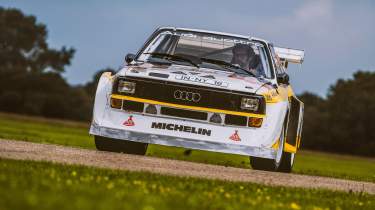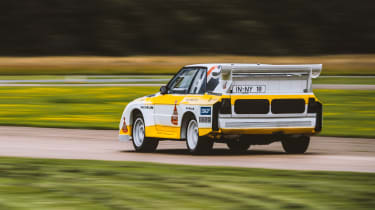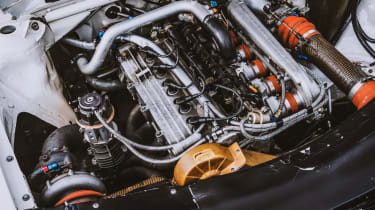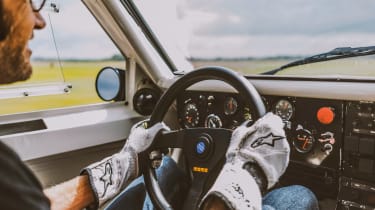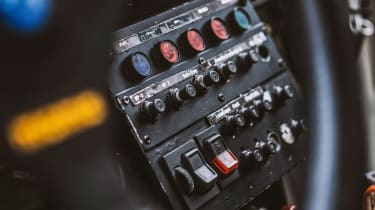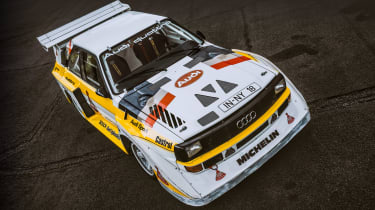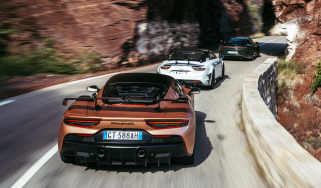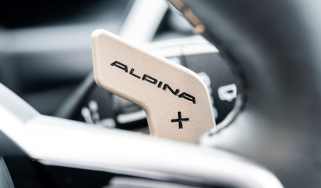Audi Sport Quattro S1: Group B rally car driven
Audi’s ballistic short-wheelbase Sport Quattro S1 was one of the stars of the fearsome Group B era. Just 20 were built and this is the most decorated survivor.
Imagine if you spent the night before a flight watching videos of planes landing in high winds. As I close my laptop and switch off the bedside light, not feeling in the least bit like sleeping, I realise I’ve probably just done something equally daft. As I put my head on the pillow, all I can see are images of Hannu and Stig leaping over the rollercoaster crests of Ouninpohja. Flames spit from from the yellow and white beasts as they slew sideways at jaw-dropping speeds, the soundtrack beautiful but angry.
As I close my eyes I’m picturing Walter waltzing, his blue Adidas pumping the pedals as he splits a sea of spectators like a motorsport Moses. It’s terrifying to see the commitment as he drives blind, save for the unheard instructions from Christian. A tight left and the car looks wild, almost untameable, the revs coming in stabs as the driver wrestles to contain it. To people like me who were too young to have witnessed it in period, Group B is almost fantastical, the equivalent of knights slaying dragons.
> 1400bhp Audi S1 ‘Hoonitron’ stars in Ken Block’s ‘Electrikhana’
And then the darkness ebbs, the morning arrives and before I know it I’m walking across the tarmac towards a set of those enormous box arches. Perhaps the most famous dragon of them all.
Just 20 Audi Sport Quattros were built in S1 (or Evolution 2) spec and this is arguably the most important of those that remain. It is chassis no. 2, which finished 2nd at Rally Finland in 1985 with Stig Blomqvist at the wheel. It is also the car that was converted to use a PDK ’box and which Walter Röhrl drove in the Network Q with Phil Short later that year. If it still existed, then chassis no. 11 would undoubtedly be the most valuable, as that was the the car that took the S1’s only victory in the World Rally Championship: Sanremo in ’85. However, incredibly, that car was scrapped.
More reviews
In-depth reviews
IN-NY18 has been owned by Audi UK since the ’90s but little used. However, after it had an engine and gearbox refresh last year, I’m about to get more seat-time than anyone in the last quarter of a century. Privileges don’t come much greater.
The livery is iconic. The blocky, bulldozer shape unmistakable. It was the first rally car that created downforce but its approach to aerodynamics is blunt. If the modern way of working with airflow is like intricate origami, this is about as delicate as reloading the printer with a wad of A4. There’s no doubt that the wings worked, though. Watch footage of the cars through the Finnish yumps and you can see how beautifully they land, slightly tail-down. Then find footage of Hannu Mikkola going through the same yumps after going off the road in ’85 and losing his rear wing – the car is permanently trying to tip forward in frightening fashion.
The idea of it flying at all seems a little unlikely when you see it static because it looks heavy thanks to its big, boxy shape. But when you waft open the almost flimsy driver’s door you’re reminded that it weighs only about 1170kg. The old Recaros look like they have been covered in a sort of grey tweed, while the backs of the seats have that honeyed weave that you only get with old Kevlar. You sit quite upright, but it’s comfortable and the cockpit feels spacious, partly because it is and partly because the white paint lends an airiness. The multiple tubes of the roll-cage ought to be a comfort too, but once you know they’re aluminium you can’t help but imagine someone scrunching an empty crisp packet.
There’s other pipework running through the cabin, down by the sills: conduits for fluids between the unusually crowded boot and the engine bay. As I pull on the red Sabelt harness, I scan the eight dials in an attempt to rank them in some vague order of importance. The boost adjuster can stay where it is today – somewhere between 450bhp and 500bhp should be plenty.
There are normal plastic stalks sprouting from the column and a Momo steering wheel that is simplicity itself, the leather smoothed by years of being tightly gripped, the curiously blue Audi badge slightly skew-whiff. If there was a family tree of exposed gear linkages, with a Pagani Huayra’s being the young, bling lottery winner in a sharp suit, this would be the plain-speaking grandfather that grafted down the mines to put food on the table and never you mind the rough edges if it gets the job done. Also on top of the patched and bulging transmission tunnel are a brake bias adjuster and a line-lock. The pedals don’t match and the overall ambience is one of a well engineered but slightly Heath Robinson competition car. It’s all at once simple but cluttered.
Deep breath. Reach down in front of the gearlever and press the innocuous looking little black button between the two red plastic engine-cutout keys. There are a few lazy, high-pitched whines from the starter motor and then the straight-five clears its throat into a deep, fast idle that fills the car. Surfaces that were still a moment before are now alive with vibrations large and small.
Unsurprisingly the clutch is heavy, the quadriceps in my left leg getting a workout as I push the pedal a couple of times to get a feel for the weighting. In contrast, the gearshift feels quite light and, although the throw isn’t that long, there isn’t the sense of a tightly defined gate to give clarity to the movements. Revs, clutch, try to find the biting point but then not slip it… and with a heavy-duty stutter we’re away.
An exploratory waggle of the wheel at low speed reveals all sorts of conflicting forces as the diffs fight for control, but the lack of weight in the car is again apparent. A couple of short shifts reveal more reassurance in the gearbox than I first thought. And then, turning onto the back straight, the time for prevarication is over.
Third gear, squeeze the throttle, listen to the evocative five-cylinder warble as the revs build and then at 6000rpm… BOOM! The S1 explodes forwards like a sprinter startled out of the blocks, rearing up at the front and then weaving left and right like a dog sniffing the air. Everything seems to happen at once. I want to keep a firm grasp of the wheel but I also need to change up. I want to keep looking where the car’s taking me, but I also want to look at the rev-counter. As I go for fourth there is the wonderful tcheeew from the whistling wastegate and the nose dips then rises again briefly before I brake early. Wow.
This is the sort of turbocharged delivery your mother warned you about. The blast of boost is all-consuming. It’s not a clean shove of linear g-force, it’s a dirty detonation that infects the whole car. Short of Doc’s DeLorean reaching 88mph, there can’t be many cars that undergo such an alarming transformation. It reminds me of a Ferrari F40, which is a similar weight and has a similar power output, but this is even more violent. Even rawer. The gearing feels shorter and the single big turbo delivers its delayed wallop with even more ferocity. It’s genuinely unsettling, but also primordially exciting.
Next time around the track I enter the tight right-hander onto the straight with more commitment and get on the throttle earlier in second gear. I’ve just about got the car straight as the needle accelerates past 6000rpm. The ancient and now unobtainable Michelins momentarily lose their grip and this time I’m adding corrective lock as the engine note hardens. The slide itself is relatively contained but having to take one hand off the wheel to change gear makes it all feel more frantic.
Even the space of a small airfield feels quite restrictive in an S1, so what it must have been like on narrow mountain passes or through tight streets is almost unfathomable. Walter Röhrl said that it was a car in which you needed to think two corners ahead and I can see why. When the boost kicks in there is a relentless, runaway feeling to the car. You’re riding a wave in a storm.
One of the big changes with the S1 compared with the standard Shorty was that as much weight was moved rearwards as possible. Open the boot and you’ll find the battery, alternator, oil cooler and radiator with two fans all huddled in there. It helped, but the five-cylinder slung out over the front means that the weight distribution is still an imperfect 55:45, front:rear. As such, it isn’t a car that likes tighter corners, the front wanting to push on. It needs a bit of cajoling. And as careful as I want to be with this precious piece of history, you have to drive it very positively. You can’t let it drive you.
Of course I’ve got the advantage of doing laps, redoing the same turns and finding the best combination of inputs. Yet getting into a flow or achieving any sort of repeatability seems difficult verging on impossible. But the satisfaction is so sweet when all your efforts combine in a corner to get the car rotating early enough and the boost arriving right on time so that the diffs lock, resulting in the car being hurled forward without hesitation. Then it’s a car that leaves you smiling and sweating.
The terrifying thing is that an S1 would have been even more unruly back in the day thanks to an early form of anti-lag. Called Umluft, which translates as ‘circulating air’, it was all but essential because of the size of the turbocharger on the S1. The big turbo gave big boost but also the big lag that I’m experiencing. You can tell if Umluft is fitted because there will be a second wastegate next to the main one under the bonnet in order to regulate the intake-side flow to the turbocharger. Although it was effective, the problem was that it also burned exhaust valves and manifolds. As a result it’s simply not worth running the system these days.
Something else that isn’t used these days (but could be) is the small red sphere under the bonnet that’s affectionately known as The Bomb. This is the heart of a hydraulic system that was triggered by the small white button on the forward part of the top of the gearlever. When the system was activated, this button would instantly dip the clutch pedal with the piston that you can see mounted above it. Except dip is far too meek a word. It would smash the pedal to the bulkhead with unmitigated ferocity.
It was crude, but on a special stage it worked brilliantly as it allowed the drivers much more freedom to left-foot brake. However, in the service park the system was responsible for left- foot breaking, crushing the metatarsals of more than one poor, unsuspecting or wearily inattentive mechanic.
The final thing that was used in period but now lies dormant is the PDK gearbox. Audi UK actually owns the dual-clutch ’box but as it’s a different size and shape to the H-pattern, it’s not the work of a moment to fit. The aforementioned bulges and patch-plates on the transmission tunnel show where it was squeezed in in the past.
It certainly improved performance, dropping the 0-60mph time on gravel from 3.1sec to 2.5sec. Röhrl first used the ’box in competition on the Semperit Rally in Austria in 1985 and won by a staggering 18 minutes. It was fitted again for the RAC in November that year, but with less success. The first problem was that Röhrl snapped the small lever that was used to change gear, so his co-driver, Phil Short, had to jam a screwdriver in the slot instead. The other problem was that it was very difficult to know which gear you were in and this was almost certainly a factor when the car left the road and rolled down a hillside in SS15 (Rheola).
Given how ferocious the S1 feels today, the mind boggles at the thought of it with another 100bhp, Umluft and the PDK ’box. Even after a couple of hours behind the wheel, once I’m used to the weight (im)balance and familiar with the responses of all the controls and, as far as possible, comfortable with the car, I still don’t feel as though I’m totally in control when the needle hits 6000rpm and the torque curve goes vertical. It has a rawness that is impossible to subdue.
But that’s exactly how I hoped it would be. I wanted the experience of driving this car to elevate my admiration for the likes of Mikkola and Mouton even higher. I wanted to know that my belief in their bravery and skill was entirely justified. Suffice to say that watching some of the clips again after wrestling with the S1, I was even more slack-jawed at what I was seeing on the screen.
Juha Kankkunen once said ‘WRC is for boys, Group B was for men.’ I always thought that was a bit disrespectful (and not just to the runner-up in the 1982 drivers’ championship). After all, Group A cars were going faster only a few years later. And I defy anyone to be dismissive about the sheer speed and constant commitment that the current WRC cars demand from their drivers. But, having driven the S1, I now know what Juha was getting at. There is a powerful physicality and bare-knuckle brutality that I haven’t experienced in any other rally car. I think it boils down to the fact that in 1985/86 engines were writing monstrous cheques that the chassis were struggling to cash, and that imbalance hasn’t been present in rallying since. Group B has a reputation and it is entirely deserved.
Audi Sport Quattro S1 specs
| Engine | In-line 5-cyl, 2142cc, turbo |
| Power | 476bhp @ 7500rpm |
| Torque | 354lb ft @ 5500rpm |
| Weight | 1170kg |
| Power-to-weight | 413bhp/ton |
| 0-62mph | 3.1sec |
| Top speed | n/a |
This story was first featured in evo issue 292. To purchase any back issues, or subscribe visit our online shop here

